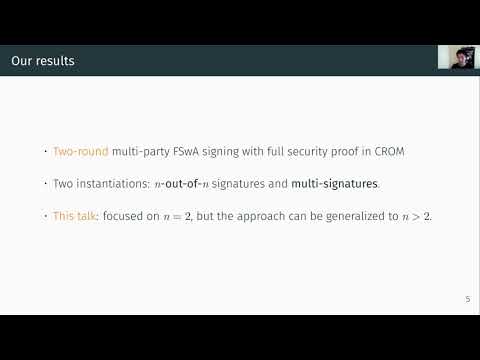CryptoDB
Two-round n-out-of-n and Multi-Signatures and Trapdoor Commitment from Lattice
| Authors: | |
|---|---|
| Download: | |
| Presentation: | Slides |
| Abstract: | Although they have been studied for a long time, distributed signature protocols have garnered renewed interest in recent years in view of novel applications to topics like blockchains. Most recent works have focused on distributed versions of ECDSA or variants of Schnorr signatures, however, and in particular, little attention has been given to constructions based on post-quantum secure assumptions like the hardness of lattice problems. A few lattice-based threshold signature and multi-signature schemes have been proposed in the literature, but they either rely on hash-and-sign lattice signatures (which tend to be comparatively inefficient), use expensive generic transformations, or only come with incomplete security proofs. In this paper, we construct several lattice-based distributed signing protocols with low round complexity following the Fiat--Shamir with Aborts (FSwA) paradigm of Lyubashevsky (Asiacrypt 2009). Our protocols can be seen as distributed variants of the fast Dilithium-G signature scheme and the full security proof can be made assuming the hardness of module SIS and LWE problems. A key step to achieving security (unexplained in some earlier papers) is to prevent the leakage that can occur when parties abort after their first message---which can inevitably happen in the Fiat--Shamir with Aborts setting. We manage to do so using homomorphic commitments. Exploiting the similarities between FSwA and Schnorr-style signatures, our approach makes the most of observations from recent advancements in the discrete log setting, such as Drijvers et al.'s seminal work on two-round multi-signatures (S&P 2019). In particular, we observe that the use of commitment not only resolves the subtle issue with aborts, but also makes it possible to realize secure two-round n-out-of-n distributed signing and multi-signature in the plain public key model, by equipping the commitment with a trapdoor feature. The construction of suitable trapdoor commitment from lattices is a side contribution of this paper. |
Video from PKC 2021
BibTeX
@article{pkc-2021-30976,
title={Two-round n-out-of-n and Multi-Signatures and Trapdoor Commitment from Lattice},
booktitle={Public-Key Cryptography - PKC 2021},
publisher={Springer},
doi={10.1007/978-3-030-75245-3_5},
author={Ivan Damgård and Claudio Orlandi and Akira Takahashi and Mehdi Tibouchi},
year=2021
}

